Gurjar
| Regions with significant populations | |
|---|---|
| South Asia | |
| Languages | |
| Gojri • Gujarati • Hindi • Kashmiri • Punjabi • Urdu • Pashto • Haryanvi • Sindhi • Balochi • Pahari • Bhojpuri • Marathi | |
| Religion | |
| Hinduism | |
| Related ethnic groups | |
| Jats • Rajputs • Ahirs and other Indo-Aryan People |
The Gurjar (or Gujjar, Gujar, Gurjara[1]) are an agricultural[2] ethnic community, residing mainly in India, Pakistan, and Afghanistan,[3] divided internally into various clan groups.[3] They were traditionally involved in agriculture, pastoral and nomadic[4][5][6] activities and formed a large heterogeneous group.[7] The historical role of Gurjars has been quite diverse in society: at one end they have been found related to several kingdoms and, at the other end, some are still nomads with no land of their own.[1][8]
The pivotal point in the history of Gurjar identity is often traced back to the emergence of a Gurjara kingdom in present-day Rajasthan and Gujarat during the Middle Ages (around 570 CE).[9] It is believed that the Gurjars migrated to different parts of the Indian Subcontinent from the Gurjaratra.[10]
The Gurjaras started fading from the forefront of history after the 10th century CE. Thereafter, history records several Gurjar chieftains and upstart warriors, who were rather petty rulers in contrast to their predecessors. Gujar or Gujjar were quite common during the Mughal era, and documents dating from the period mention Gujars as a 'turbulent' people.
The Indian states of Gujarat and Rajasthan were known as Gurjaradesa and Gurjaratra for centuries prior to the arrival of the British. The Gujrat and Gujranwala districts of Pakistani Punjab have also been associated with Gurjars from as early as the 8th century CE, when there existed a Gurjara kingdom in the same area.[11][12] The Saharanpur district of Uttar Pradesh was also known as Gurjargadh previously, due to the presence of many Gurjar zamindars in the area.[13]
Gurjars are linguistically and religiously diverse. Although they are able to speak the language of the region and country where they live, Gurjars have their own language, known as Gujari. They variously follow Hinduism, Islam, and Sikhism.[14][15]
The Hindu Gurjars are mostly found in Indian states of Rajasthan, Gujarat, Haryana, Madhya Pradesh, Punjab Plains and Maharashtra. Muslim Gurjars are mostly found in Pakistani province of Punjab, mainly concentrated in Lahore and northern cities of Gujranwala, Gujrat, Gujar Khan and Jhelum; Indian Himalayan regions such as Jammu & Kashmir, Himachal Pradesh, and Garhwal and Kumaon divisions of Uttarakhand; and Afghanistan.
Etymology
The word Gujjar represents a caste, a tribe and a group in India, Pakistan, and Afghanistan, locally referred to as jati, zaat, qaum or biradari.[16][17]
It has been suggested by several historians that Gurjara was initially the name of a tribe or clan which later evolved into a geographical and ethnic identity following the establishment of a janapada (tribal kingdom) called 'Gurjara'.[18] This understanding has introduced an element of ambiguity regarding ancient royal designations containing the word 'gurjara' such as gurjaraeshvara or gurjararaja, as now it is debatable whether the kings bearing these epithets were tribal or ethnic Gurjaras.[19][20]
History
Origin
Historians and anthropologists differ on the issue of Gurjar origin. According to one view, circa 1 CE, the ancient ancestors of the Gurjars came in multiple waves of migration and were initially accorded status as high-caste warriors in the Hindu fold in the North-Western regions (modern Rajasthan and Gujarat).[21] Aydogdy Kurbanov states that some Gurjars, along with people from northwestern India, merged with the Hephthalites to become the Rajput clan.[22]
Previously, it was believed that the Gurjars had migrated earlier on from Central Asia as well, however, this view is generally considered to be speculative.[23]
According to B. D. Chattopadhyaya, historical references speak of Gurjara warriors and commoners in North India in the 7th century CE, and mention several Gurjara kingdoms and dynasties.[24] However, according to Tanuja Kothiyal, the historical image of Gurjars is that of "ignorant" herders, though historical claims of Gurjar past also associate them with Gurjara-Pratiharas. She cites a myth that any Rajput claim Gurjars may have comes through a Rajput marrying a Brahmin woman, and not through an older Kshatriya clan.[25] She says that the historical process suggests the opposite: that Rajputs emerged from other communities, such as Gurjars, Jats, Raikas etc.[26]
The oldest known reference to the word Gurjara is found in the book called Harshacharita (Harsha's Deeds), a biography of king Harshavardhana written around 630 CE.[27] Banabhatta, the author of Harshacharita, mentions that Harsha's father Prabhakravardhana (560-580 CE) was "a constant threat to the sleep of Gurjara"—apparently a reference to the Gurjara king or kingdom. Inscriptions from a collateral branch of Gurjaras, known as Gurjaras of Lata, claim that their family was ruling Bharakucha (Bharuch) as early as 450 CE from their capital at Nandipuri.
According to scholars such as Baij Nath Puri, the Mount Abu (ancient Arbuda Mountain) region of present-day Rajasthan had been an abode of the Gurjars during the medieval period.[28] These Gurjars migrated from the Abu mountain region and as early as in the 6th century CE, they set up one or more principalities in Rajasthan and Gujarat. The whole or a larger part of Rajasthan and Gujarat had been long known as Gurjaratra (country ruled or protected by the Gurjars) or Gurjarabhumi (land of the Gurjars) for centuries prior to the Mughal period.[29]
In Sanskrit texts, the ethnonym has sometimes been interpreted as "destroyer of the enemy": gur meaning "enemy" and ujjar meaning "destroyer").[30][31]
Medieval period
Babur, in the context of revolt, wrote that Jats and Gujjars poured down from hills in vast numbers in order to carry off oxen and buffaloes and that they were guilty of the severest oppression in the country.[32] Many Gurjars were converted to Islam at various times, dating back to Mahmud of Ghazni's raid in Gujarat in 1026. Gurjars of Awadh and Meerut date their conversion to Tamerlane, when he sacked Delhi and forcibly converted them. By 1525, when Babur invaded India, he saw that the Gurjars of northern Punjab were already Muslims. Until the 1700s, conversions continued under Aurangzeb, who converted the Gurjars of Himachal Pradesh by force. Pathans and Balochis drove Gurjar converts out of their land, forcing them into vagrancy.[33]
British rule
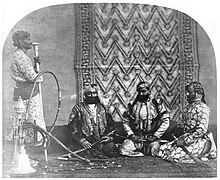
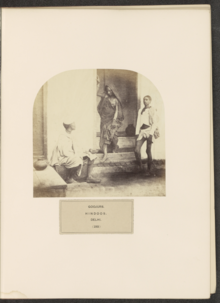
In the 18th century, several Gurjar chieftains and small kings were in power. A fort in Parikshitgarh in Meerut district, also known as Qila Parikishatgarh, is ascribed to a Gurjar king Nain Singh Nagar.[34][better source needed] Morena, Samthar, Dholpur, Saharanpur and Roorkee were also some of the places ruled by Gurjar kings.[35][36] Bhati Clan of Gurjars had significance influence in Bulandshahr joint magistracy. Rao Roshan Singh of Bhati clan was a landlord of wide area till 1812, other chiefs of this clan were, Shambu Singh, Ajit singh and Dargahi Singh Bhati. The Bhati Gurjars in this area had somewhat similar position as the Gurjar Rajas of Saharanpur area.[37]
In Delhi, the Metcalfe House was sacked by Gurjar villagers from whom the land had been taken to erect the building.[38] In September 1857, the British were able to enlist the support of many Gurjars at Meerut.[39]
Culture
Afghanistan
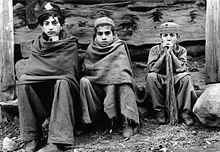
The Gurjar people are a tribal group who have lived in Afghanistan for centuries. According to the Afghanistan news agency Pajwok Afghan News, there are currently an estimated 1.5 million Gurjar people residing in the country. The Gurjar people are predominantly found in the northeastern regions of Afghanistan, including Kapisa, Baghlan, Balkh, Kunduz, Takhar, Badakhshan, Nuristan, Laghman, Nangarhar, and Khost. They have a distinct culture and way of life.[40]
The old Afghanistan constitution recognised 14 ethnic groups officially with the Gurjar ethnic group being one of them.[40]
Many Gurjar tribal people in Afghanistan are deprived of their rights and their living conditions are poor. They have sometimes been internally displaced in the past by illegal militias; for example, during 2018 around 200 Gurjar families were displaced from their homes in Farkhar district in Takhar province.[41]
During the corona virus pandemic, the Gurjar people in the northeastern province of Badakhshan used Andak meat to treat the corona virus, due to lack of clinics and other health facilities in their areas. The Gurjar Tribe Council deemed the meat of the Andak animal as haram (forbidden) but many Gurjar people in the area said they had no choice.[40]
Gurjar tribal leaders met with Hamid Karzai when he was President of Afghanistan. They demanded schools and hospitals be built in their areas and the Afghan government give scholarships to Gurjar students to study abroad.[42]
India
Today, the Gurjars are classified under the Other Backward Class category in some states in India.[43] However, in Jammu and Kashmir and parts of Himachal Pradesh, they are designated as a Scheduled Tribe under the Indian government's reservation program of positive discrimination. Hindu Gurjars were assimilated into several varnas.[44]
Delhi
Gurjars form an important component of Delhi. They have combined their traditional occupation of pastoralism and marginal cultivation over a large area in and around Delhi.[45]
Haryana
The Gurjar community in Haryana has set elaborate guidelines for solemnizing marriages and holding other functions.[46] In a mahapanchayat ("the great panchayat"), the Gujjar community decided that those who sought dowry would be excommunicated from the society.[47]
Rajasthan
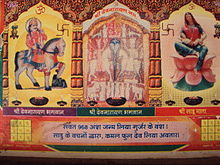
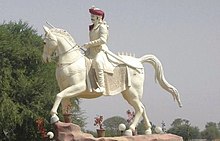
The Rajasthani Gurjars worship Surya, Devnarayan (an avatar of Vishnu), Shiva and Bhavani.[48][49]
In Rajasthan, some members of the Gurjar community resorted to violent protests over the issue of reservation in 2006 and 2007. They demanded a change in their status from Other Backward Class (OBC) to Scheduled Tribe (ST). They felt marginalized and faced livelihood crises. During the 2003 election to the Rajasthan assembly, the Bharatiya Janata Party (BJP) promised them Scheduled Tribe status.[50][51] However, the party failed to keep its promise after coming to the power, resulting in protests by the Gurjars in September 2006.[52]
In May 2007, during violent protests over the reservation issue, members of the Gurjar community clashed with the police.[53] Subsequently, the Gurjar protested violently, under various groups including the Gurjar Sangarsh Samiti,[54] Gurjar Mahasabha[55] and the Gurjar Action Committee.[56] Presently, the Gurjars in Rajasthan are classified as Other Backward Classes.[57]
On 5 June 2007, Gurjars rioted over their desire to be added to the central list of tribes who are given favoured treatment under the reservation system However, other tribes on the list oppose this request, as it would make it harder to obtain the few positions already set aside.[58]
In December 2007, the Akhil Bhartiya Gurjar Mahasabha ("All-India Gurjar Council") stated that the community would boycott the BJP, which was in power in Rajasthan.[59] But in 2009 the Gurjar community was supporting BJP so that they could be politically benefitted. Kirori Singh Bainsla fought and lost on the BJP ticket. In the early 2000s, the Gurjar community in Dang region of Rajasthan was also in news its falling sex ratio, unavailability of brides, and the resultant polyandry.[60][61]
Madhya Pradesh
As of 2022[update], the Gurjars in Madhya Pradesh are classified as Other Backward Classes.[62]
Maharashtra
In Maharashtra, Gurjars are in very good numbers in Jalgaon District. Dode Gurjars and Dore Gurjars are listed as Other Backward Classes in Maharashtra.[63]
Gujarat
The State took its name from the Gurjara, the land of the Gurjars, who ruled the area during the 700s and 800s.[64]
They are listed among the Other Backward Classes of Gujarat.[65]
A few scholars believe that the Leva Kunbis (or Kambis) of Gujarat, a section of the Patidars, are possibly of Gurjar origin.[66][67] However, several others state that the Patidars are Kurmis or Kunbis (Kanbis);[68] Gurjars are included in the OBC list in Gujarat but Patidars are not.[65]
Gurjars of North Gujarat, along with those of Western Rajasthan and Punjab, worship Sitala and Bhavani.[49]
Himachal Pradesh
As of 2001[update], the Gurjars in parts of Himachal Pradesh were classified as a Scheduled Tribe.[69]
Jammu and Kashmir
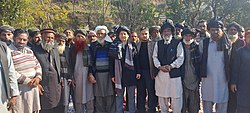
The Gurjars and Bakerwals tribes of Jammu and Kashmir were declared a Scheduled Tribe (ST) in 1991.[70] At the 2001 census, they were found principally in Rajouri, Poonch, Reasi, Kishtwar district, with presences elsewhere.[71] It is believed that Gurjars migrated to Jammu and Kashmir from Gujarat (via Rajasthan) and Hazara district of Khyber Pakhtunkhwa.[72]
As of 2011[update], the Gurjars and the Bakarwals in Jammu and Kashmir were classified as Scheduled Tribes constitute 12% of the total population of Jammu and Kashmir. However, they claim that they constitute more than 20% of the population, and allege undercounting because of their nomadic lifestyle, saying that when the censuses were held in 2001 and 2011, half of their population had been in the upper reaches of the Himalaya.[69][73] According to the 2011 Census of India, Gurjars are the most populous scheduled tribe in Jammu and Kashmir, having a population of nearly 1.5 million. Nearly all of them follow Islam.[74]
The Gurjars of Jammu and Kashmir in 2007 demanded that this tribal community be treated as a linguistic minority in the erstwhile state and provided with constitutional safeguards for their language Gojri. They also pressured the state government to urge the central government to include Gojri in the list of official languages of India.[75]
In 2002, some Gurjars and Bakarwals in Jammu and Kashmir demanded a separate state called Gujaristan for Gujjar and Bakarwal communities, under the banner of All India Gurjar Parishad.[76] Gurjars and Bakarwals have at times been targeted by militants of the insurgency in the territory, such as during the Kot Charwal and Teli Katha massacres.
Uttarakhand
The Van Gujjars ("forest Gurjars") are found in the Shivalik Hills area of Uttarakhand. The Van Gujjars follow Islam, and they have their own clans, similar to the Hindu gotras.[77] They are a pastoral semi-nomadic community, practising transhumance. In the winter season, the Van Gujjars migrate with herds of semi-wild water buffalo to the Shivalik Hills at the foot of the Himalayas, and in summer, they migrate to alpine pastures higher up the Himalayas. The Gurjars sell milk to local peoples as their primary source of income. They treat their animals with great care and do not eat them nor sell them for meat.[78][page needed]
The Van Gujjars have had conflicts with forest authorities, who prohibited human and livestock populations inside reserved parks.[77] However, India's Forest Rights Act of 2006 granted rights to "traditional forest dwellers" to the lands they have relied on for generations. The conflict between local forest officials, who claim rights over the newly created parks, and the thousand year nomadic traditions of the Van Gujjars has been ongoing.[78][79]
Pakistan
It has been estimated that Gujjars comprise 20% of Pakistan's total population.[80]
In 1999, British anthropologist Stephen Lyon estimated their total population in Pakistan to number 30 million and theorized the notion of "Gujarism", the fact that Gujjars in Pakistan are conscious of their identity and often base their social activities, such as local political participation, on this basis, what he calls kin-network activism.[81]
Punjab
Gujjars are mostly found in the country's Punjab province, where they gave their name to cities and towns such as Gujranwala, Gujar Khan and Gujrat, but for economics reasons recently they have emigrated to cities such as Karachi.[82]
Khyber Pakhtunkhwa
Gujjars are also present in Khyber Pakhtunkhwa, where they're the third largest ethnic groups after the Pashtuns and the Awan, found in the Hazara region as well places like Dir, Swat, and Bajaur, often being conversant in Pashto, the provincial language.[83]
In Swat, Pir Samiullah was a Gujjar community leader who was the first to raise a private tribal army against the Pakistani Taliban, with around 10,000 men, but was eventually defeated and executed by the Taliban in 2008, who then desecrated his dead body by hanging it publicly.[84]
Azad Kashmir
In Azad Kashmir, they are one of the region's largest communities, by some estimates even being considered the single largest group with 800,000 individuals.[85][86]
See also
- Gurjaradesa
- Gurjaras of Mandavyapura
- Bhadanakas
- Muslim Gujjars
- Pratihar Gurjars
- List of Gurjar clans
- List of Gurjars
References
- ^ a b Mayaram, Shail (2017). "The Story of the Gujars". In Vijaya Ramaswamy (ed.). Migrations in Medieval and Early Colonial India. Taylor & Francis. p. 67. ISBN 978-1-351-55825-9.
The heterogeneous category that is variously called gujar/Gujjar/Gurjara.
- ^ Zelin, Madeleine (6 October 2015). Merchant Communities in Asia, 1600–1980. Routledge. p. 148. ISBN 978-1-317-31789-0.
- ^ a b Rahi, Javaid, ed. (2012). The GUJJARS - A Book Series on History and Culture of Gujjar Tribe. Vol. 1.
- ^ "Welfare measures of nomadic Gujjar and Bakarwal tribes to be taken". The Tribune. 3 March 2022. Retrieved 3 March 2022.
- ^ "As seen from the eyes of nomadic tribes". The Indian Express. 18 February 2022. Retrieved 18 February 2022.
- ^ "Finding identity: Nomadic Gujjar tribes". Independent. 29 July 2021. Retrieved 29 July 2021.
- ^ Rahi, Javaid, ed. (2016). "The GUJJARS - A Book Series on History and Culture of Gujjar Tribe". The Gujjars -Vol: 06- ed Javaid Rahi. 6.
- ^ Agnihotri, V. K. “The Gujjars are pastoral and nomadic. They wander throughout the year in search of grazing pastures for their cattle which mostly consists of buffaloes and cows. Gujjars are Hindus as well as Muslims though the bulk of them are Muslims. Muslim Gujjar is a nomad and therefore, has no settled home in any part of Himachal Pradesh. Today Hindu Gujjars mostly lead a settled life.”; Vora, Rajendra (2002). Socio-economic Profile of Rural India: North-central & western India (Himachal Pradesh, Punjab, Haryana, Gujarat, Maharashtra). Concept Publishing Company. ISBN 978-81-8069-206-2.
{{cite book}}: CS1 maint: multiple names: authors list (link) - ^ Baij Nath Puri (1957). The History Of The Gurjara Pratiharas (PhD thesis) – via Internet Archive.
- ^ Chattopadhyaya 1994, p. 6 "we have noted that Gurjaratra or Gurjarabhumi was the base from which several lineages tracing descent from the Gurjaras emerged"
- ^ Baij Nath Puri 1957, p. 12.
- ^ Buddha Prakash (1965). Aspects of Indian History and Civilization. Shiva Lal Agarwala. p. 157. ISBN 9780842616812.
- ^ Baij Nath Puri (1975). The History of the Gurjara-Pratihāras. Oriental Publishers & Distributors. pp. 14–17.
- ^ "Nuristan". Program for Culture & Conflict Studies. Naval Postgraduate School. October 2009. Retrieved 4 November 2013.
- ^ Singh 2012, pp. 48 & 51.
- ^ Gloria Goodwin Raheja (15 September 1988). The Poison in the Gift: Ritual, Prestation, and the Dominant Caste in a North Indian Village. University of Chicago Press. pp. 01–03. ISBN 978-0-226-70729-7.
This regional dominance and the kingship (rajya) exercised by Gurjar chiefs still figure prominently in oral traditions current among Saharanpur Gurjars and in the depiction of their identity as Ksatriya "kings" in printed histories of the Gujar Jati.
- ^ Muhammad Asghar (2016). The Sacred and the Secular: Aesthetics in Domestic Spaces of Pakistan/Punjab. LIT Verlag Münster. p. 10. ISBN 978-3-643-90836-0.
The main grouping is the biradari, which is a very old established norm of people identifying themselves ... A larger and also ancient form of grouping is the caste (qaum). The three main ones are Jaats (farmers), Arains (who traditionally were gardeners) and Gujjars (people who tend livestock and sell milk).
- ^ Chattopadhyaya 1994, p. 6.
- ^ Sharma, Sanjay (2006). "Negotiating Identity and Status". Studies in History. 22 (2): 181–220. doi:10.1177/025764300602200202. ISSN 0257-6430. S2CID 144128358.
- ^ Sharma, Shanta Rani (2012). "Exploding the Myth of the Gūjara Identity of the Imperial Pratihāras". Indian Historical Review. 39 (1): 1–10. doi:10.1177/0376983612449525. ISSN 0376-9836. S2CID 145175448.
- ^ Singh 2012, pp. 44–
- ^ Kurbanov, Aydogdy (2010). "The Hephthalites: Archaeological and Historical Analysis" (PDF). p. 243. Retrieved 11 January 2013.
As a result of the merging of the Hephthalites and the Gujars with population from northwestern India, the Rajputs (from Sanskrit "rajputra" – "son of the rajah") formed.
- ^ Mayaram, Shail (2017). "The Story of the Gujars". In Vijaya Ramaswamy (ed.). Migrations in Medieval and Early Colonial India. Taylor & Francis. p. 67. ISBN 978-1-351-55825-9.
- ^ Chattopadhyaya 1994, p. 64. "documents dating from seventh century suggest a wide distribution of Gurjaras as a political power in western India"
- ^ Kothiyal, Tanuja (14 March 2016). Nomadic Narratives: A History of Mobility and Identity in the Great Indian Desert. Cambridge University Press. pp. 249–250. ISBN 978-1-107-08031-7.
The cultural image of the Gujar is of an ignorant herder though the historical claims of Gujar past also associate them with Gurjara-Pratiharas, with long migrations through Thar. However, as the Devnarayan epic reveals, any Rajput link that the Gujars may claim, comes from multi-caste marriages that are contracted in the course of the epic rather than any other claim to descent from the older kshatriya clan. The original ancestor of the Gujars is a Rajput, who marries a Brahmin woman.
- ^ Kothiyal, Tanuja (14 March 2016). Nomadic Narratives: A History of Mobility and Identity in the Great Indian Desert. Cambridge University Press. p. 265. ISBN 978-1-107-08031-7.
from gradual transformation of mobile pastoral and tribal groups into landed sedentary ones. The process of settlement involved both control over mobile resources through raids, battles and trade as well as channelizing of these resources into agrarian expansion. Kinship structures as well as marital and martial alliances were instrumental in this transformation. ... In the colonial ethnographic accounts rather than referring to Rajputs as having emerged from other communities, Bhils, Mers, Minas, Gujars, Jats, Raikas, all lay a claim to a Rajput past from where they claim to have 'fallen'. Historical processes, however, suggest just the opposite.
- ^ Puri, Baij Nath (1986). The History of the Gurjara-Pratiharas. Delhi: Munshiram Manoharlal. p. 9.
- ^ Kulbhushan Warikoo; Sujit Som. Gurjars of Jammu and Kashmir. Indira Gandhi Rashtriya Manav Sangrahalaya.
Dr. B. N. Puri who wrote a thesis Gurjar Pratihar at oxford university states that the Gurjars were local people
- ^ Ramesh Chandra Majumdar; Achut Dattatrya Pusalker; A. K. Majumdar; Dilip Kumar Ghose; Vishvanath Govind Dighe; Bharatiya Vidya Bhavan (1977). The History and Culture of the Indian People: The classical age. Bharatiya Vidya Bhavan. p. 153.
- ^ Warikoo, Kulbhushan; Som, Sujit (2000). Gurjars of Jammu and Kashmir. Indira Gandhi Rashtriya Manav Sangrahalaya. p. 4.
"Gurjar" is a Sanskrit word which has been explained thus: Gur+Ujjar;'Gur' means 'enemy' and 'ujjar' means 'destroyer'. The word means "Destroyer of the enemy".
- ^ Parishada, Bhāratīya Gurjara (1993). Gurjara aura Unakā Itihāsa meṃ Yogadāna Vishaya para Prathama …, Volume 2. Bharatiya Gurjar Parisha. p. 27.
Sanskrit Dictionary Compiled by Pandit Radha Kant (Shakabada 1181) explains: Gurjar=Gur (enemy)+Ujar(destroyer)
- ^ Shail Mayaram (2004). Against History, Against State: Counterperspectives from the Margins. Permanent Black. p. 94. ISBN 978-81-7824-096-1.
- ^ Sharma, J. C., (1984). "Gujars". In Muslim Peoples: A World Ethnographic Survey. Vol. 1. pp. 298–301. edited by Richard V. Weekes. Westport, Conn.: Greenwood Press.
- ^ "Tourist Places". District Administration Meerut. Archived from the original on 19 June 2009. Retrieved 31 May 2007.
- ^ "Roorkee Cantonment Board - History". Retrieved 2 September 2021.
- ^ "Culture & Heritage". Retrieved 20 September 2021.
- ^ Kolff, Dirk H.A. (13 August 2010). Grass in their mouths: The Upper Doab of India under the company's Magna Charta, 1793-1830. Brill. p. 149. ISBN 978-90-04-18802-0.
- ^ Sen, Geeti; Ashis Banerjee (2001). The Human Landscape. Orient Longman. p. 236. ISBN 978-81-250-2045-5.
- ^ C.R. Bijoy (February 2003). "The Adivasis of India – A History of Discrimination, Conflict, and Resistance". PUCL Bulletin. People's Union for Civil Liberties. pp. 55–61.
- ^ a b c Hamdard, Azizullah (January 2021). "Gujars use Andak meat for coronavirus treatment". Retrieved 15 March 2023.
Reaching in numbers almost 1.5 million, Gujar tribe men and women live in parts of Kapesa, Baghlan, Balkh, Kunduz, Takhar, Badakhshan, Nuristan, Laghman, Nangarhar and Khost provinces.
- ^ "Gujar tribesmen forcibly evicted from Takhar homes". February 2018. Retrieved 20 March 2023.
- ^ "Karzai assures to consider Gujar tribe demands". September 2013. Retrieved 15 March 2023.
- ^ Page, Jeremy (30 May 2008). "India's Gujjar caste fight for a downgrade". The Times. Archived from the original on 4 November 2013. Retrieved 1 December 2009.
- ^ Sharma, R. S. (2003). Early medieval Indian society: a study in feudalisation. Orient Longman Private Limited. p. 207. ISBN 978-81-250-2523-8. Retrieved 30 November 2009.
It would be wrong to think that all foreigners were accepted as kshatriya and Rajputs for, in course of time, the Gujar people broke up into brahmans, banias, potters, goldsmiths, not to speak of herdsmen and cultivators (kunbis), who were looked upon as sudras.
- ^ Dabral, Shweta; Malik, S.L. (2004). "Demographic Study of Gujjars of Delhi: Population Structure and Socio-cultural Profile". Journal of Human Ecology. 16: 17–24. doi:10.1080/09709274.2004.11905710. ISSN 0970-9274. S2CID 55355163.
- ^ Chattar Pal Tanwar (3 August 2003). "Anti-dowry campaign renewed before marriage season". The Tribune. Chandigarh. Retrieved 31 May 2007.
- ^ Parmindar Singh (29 June 2003). "No band, no dhol, and just 11 baratis". The Tribune. Chandigarh. Retrieved 31 May 2007.
- ^ Daniel Neuman; Shubha Chaudhuri; Komal Kothari (2007). Bards, ballads and boundaries: an ethnographic atlas of music traditions in West Rajasthan. Seagull. ISBN 978-1905422074.
Devnarayan is worshipped as an avatar or incarnation of Vishnu. This epic is associated with the Gujar caste
- ^ a b Indian studies: past & present, Volume 11. Today & Tomorrow's Printers & Publishers. 1970. p. 385.
The Gujars of Punjab, North Gujarat and Western Rajasthan worship Sitala and Bhavani
- ^ "Gujjar of Rajasthan and ST Status". Countercurrents.org. 6 June 2008. Retrieved 24 June 2009.
- ^ Mayaram, Shail (June 2014). "Pastoral predicaments: The Gujars in history". Contributions to Indian Sociology. 48 (2): 191–222. doi:10.1177/0069966714525163. ISSN 0069-9667.
- ^ "Gujjar community goes berserk in Rajasthan". Yahoo! News. 5 September 2006. Retrieved 31 May 2007. [dead link]
- ^ "Gujjar unrest: CPI(M) demands judicial probe". The Hindu. 30 May 2007. Archived from the original on 27 September 2007. Retrieved 31 May 2007.
- ^ "Talks between Rajasthan Government, Gujjars collapse". Zee News. 30 May 2007. Retrieved 31 May 2007.
- ^ "Gujjars seek resignation of Minister Kalulal Gujjar". Deccan Herald. 30 May 2007. Archived from the original on 29 September 2007. Retrieved 31 May 2007.
- ^ "Four dead in Gujjar-police clash in Rajasthan". The Times of India. 29 May 2007. Archived from the original on 13 January 2009. Retrieved 31 May 2007.
- ^ "Central List of Other Backward Classes: Rajasthan". National Commission for Backward Classes. Retrieved 31 May 2007.
- ^ "The Race to the Bottom of India's Ladder". Time. 5 June 2007. Archived from the original on 1 October 2007. Retrieved 26 August 2007.
- ^ "Gurjar community 'threatens' to boycott BJP". The Hindu. 31 December 2007. Archived from the original on 12 January 2009. Retrieved 31 December 2007.
- ^ Manipadma Jena (3 August 2003). "Men without women". The Hindu. Archived from the original on 21 March 2004. Retrieved 31 May 2007.
- ^ Astrid Lobo Gajiwala (7 February 2005). "Diminishing returns". National Catholic Reporter. Retrieved 31 May 2007.
- ^ "Central List of Other Backward Classes: Madhya Pradesh". National Commission for Backward Classes. Retrieved 22 January 2023.
- ^ "Central List of Other Backward Classes". National Commission for Backward Classes. Retrieved 31 May 2007.
- ^ "History of Gujarat". Gujrat State Portal. Archived from the original on 19 February 2019. Retrieved 18 May 2021.
- ^ a b "Central List of OBCs For the State of Gujarat" (PDF). Government of India.
- ^ "Buldhana: Castes". Buldhana District Gazetteer. Gazetteers Department, Cultural Affairs Department of Government of Maharashtra. Retrieved 31 May 2007.
- ^ Panjabi, Kewalram Lalchand (1977). The Indomitable Sardar. Bharatiya Vidya Bhavan. p. 4.
Vallabhbhai Patel belonged to the famous clan of Leva Gujar Patidars who played a notable role in the history of Gujarat. They were Gujars who came from Punjab and had occupied the rich charotar land between Mahi and Tapi rivers.
- ^ Pocock, David Francis (1972). Kanbi and Patidar: A Study of the Patidar Community of Gujarat. Clarendon Press. ISBN 978-0-19-823175-2.
- ^ a b "List of Scheduled Tribes". Census of India: Government of India. 7 March 2007. Archived from the original on 5 June 2010. Retrieved 27 November 2012.
- ^ "Scheduled Tribe Order" (PDF). Government of India, Tribal Affairs Department.
- ^ "Jammu & Kashmir Data Highlights: The Scheduled Tribes". Census of India 2001. Office of the Registrar General, India. Retrieved 31 May 2007.
- ^ Kapoor, A. K.; M. K. Raha; D. Basu; Satwanti Kapoor (1994). Ecology and man in the Himalayas. M. D. Publications. pp. 43–44. ISBN 978-81-85880-16-7.
- ^ "Gujjars, Bakerwals seek special census". The Tribune. New Delhi.
- ^ "Tribal Population of Gujjars, Bakerwals" (PDF). Government of Jammu and Kashmir, Tribal Affairs Department.
- ^ "Meri News". Meri News. Archived from the original on 4 September 2012. Retrieved 16 April 2009.
- ^ "Gujjars, Bakerwals demand Gujaristan in J&K". Indian Express. 29 July 2002. Archived from the original on 20 February 2005. Retrieved 31 May 2007.
- ^ a b Radhakrishna Rao (4 September 2000). "Outside the jungle book". The Hindu Business Line. Archived from the original on 28 May 2007. Retrieved 31 May 2007.
- ^ a b Michael Benanav (2018). Himalaya Bound: One Family's Quest to Save Their Animals - and an Ancient Way of Life. Pegasus Books.
- ^ Michael Benanav (31 July 2009). "Is there room for India's nomads?". Christian Science Monitor. Retrieved 8 November 2020.
- ^ "Who are the Gujjars?". Hindustan Times. 3 June 2007. Archived from the original on 15 August 2024.
In Pakistan, they comprise as much as 20 per cent of the population.
- ^ Lyon, Stephen (May 1999). "Gujars and Gujarism: simple quaum versus network activism". University of Kent. Archived from the original on 18 August 2024.
- ^ Tyagi, Vidya Prakash (2009). Martial races of undivided India. Delhi: Kalpaz. p. 240. ISBN 978-81-7835-775-1.
- ^ "Races and Tribes". Government of Khyber Pakhtunkhwa. Archived from the original on 18 August 2024.
- ^ Roggio, Bill (17 December 2008). "Taliban desecrate body of slain opposing tribal leader". FDD's Long War Journal. Archived from the original on 18 August 2024.
Samiullah was the first tribal leader in Swat to raise a lashkar, or tribal army, to oppose the Taliban. He claimed to have organized more than 10,000 tribesmen to oppose the Taliban and protect 20 villages. Samiullah and his followers are members of the Gujjar community, which is a group distinct from the dominant Pashtun tribal confederations that support the Taliban.
- ^ ""With Friends Like These...": Human Rights Violations in Azad Kashmir: II. Background". Human Rights Watch. Archived from the original on 8 March 2021. Retrieved 14 June 2019.
While the Gujjars, numbering close to eight hundred thousand, are possibly the largest such group (...)
- ^ Agency, Anadolu (17 July 2021). "Caste, ethnic loyalties decide poll favourites in AJK". The Express Tribune. Retrieved 25 October 2024.
Bibliography
- Chattopadhyaya, Brajadulal (1994). The Making of Early Medieval India. Oxford University Press. ISBN 9780195634150.
- Singh, David Emmanuel (2012). Islamization in Modern South Asia: Deobandi Reform and the Gujjar Response. Boston: Walter de Gruyter. ISBN 978-1-61451-185-4.
Further reading
- Rawat, Ajay Singh (1993), Man and Forests: The Khatta and Gujjar Settlements of Sub-Himalayan Tarai, Indus Publishing, ISBN 978-81-85182-97-1
- Hāṇḍā, Omacanda (1998), Textiles, Costumes, and Ornaments of the Western Himalaya, Indus Publishing, pp. 257–, ISBN 978-81-7387-076-7
External links
- Gurjar
- Ethnic groups in India
- Ethnic groups in Afghanistan
- Social groups of Rajasthan
- Social groups of Gujarat
- Social groups of Jammu and Kashmir
- Social groups of Khyber Pakhtunkhwa
- Social groups of Uttar Pradesh
- Social groups of Madhya Pradesh
- Social groups of Maharashtra
- Social groups of Haryana
- Social groups of Punjab, Pakistan
- Social groups of Punjab, India
- Social groups of Himachal Pradesh
- Ethnic groups in Kunar Province
- Hindu dynasties
- Punjabi tribes
- Hindkowan tribes
- Demographic history of India
- Pastoralists
- Scheduled Tribes of Jammu and Kashmir
- Scheduled Tribes of Himachal Pradesh
- Indian castes
